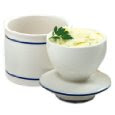Today, many consumer groups, social-service agencies and civic organization claim that margarine is better than butter because it has less calories and most are generally free of cholesterol; but the debate still continues with butter vs margarine. They further endorse that the margarine that contains water or liquid vegetable oil instead of partially hydrogenated vegetable oil is the best alternative because it is virtually free of trans-fats. However, other researchers believe butter is better. This is an old concern. Is butter better than margarine, or margarine better than butter?
Butter Vs Margarine: The Debate Continues
 Butter
Butter
Butter was first on the scene. Its invention is credited to the nomadic tribes of Asia around 3500 B.C. The term butter derives from the Greek word “buturon” meaning “cow‘s cheese“.
Butter is naturally saturated fats from animal sources. (Click here for an info graphic on How butter is made). It also contains some monounsaturated fat. It has medium-chain triglycerides with high amounts of cholesterol, but it is more rapidly absorbed as energy and so resembles carbohydrates more than fat. It also has a number of anti-oxidants, such as vitamin A and vitamin E, which margarine lacks, and has to be added in.. Most people would agree that butter tastes better than margarine and can be a flavor enhancer. The stability of butter in light, heat and oxygen makes it a good oil for frying.
Needless to say, butter is blamed to be the main cause of the growing heart disease and cancer especially as early in the 19th century. This is mainly due to butter’s saturated fat which is 7 g in every tablespoon, as compared to margarine which is 2 g in every tablespoon.
Another concern is the amount of pesticides and antibiotics contained in butter. Generally, butter contains about 5 to 10 times more pesticides than oils of vegetable origin. Some dairy farmers feed their cattle with antibiotics which finds its way into the butter. Antibiotics are known to cause allergies, tiredness, sugar craving and hypoglycemia. Antibiotics also encourage the growth of yeast in humans and antibiotic-resistant bacteria. Butter also contains trans-fatty acids (about 6%), but they are known to be more easily metabolized than the trans-fatty acids found in hydrogenated oils.
Margarine
Margarine was discovered in the 1860’s and was called margaric by a Frenchman name Hippolyte Mege-Mouriez under the initiative of Louis Napoleon III , emperor of mid-century France, who wanted a cheaper form of butter and so he held a contest. Today, margarine is a low-cost version of butter that has a similar taste and appearance to butter.
It is a common staple in the diet that contains no less than 80% fat content, similar to butter. It is primarily made of cottonseed oil and soybean oil, with smaller amounts of peanut oil, corn oil, animal oils, and skim milk. Through a process of hydrogenation, the animal or vegetable oils turn from a liquid substance into a fatty one of a semi-solid state. However, this process increases the amount of trans-fat in the margarine. So the more solid a margarine is at room temperature the more trans fat the margarine contains. Some margarine can contain as much as 3 g grams of trans-fat per tablespoon.
Margarine is a lot different from butter, so manufacturers do as much as they can to make this product appeal to the consumers’ senses in much the same way as real butter. Therefore, they use the words of “churn” to impress upon them that margarine is very much like butter. (Click here for an infographic on How margarine is made).
However, margarine lacks the natural content of real butter before it is fortified and flavored. It is rancid, smelly and unpalatable. So it is fortified and flavored. with a minimum of 9,000 U.S.P units of vitamin A per pound. It is coloured with yellow colouring (the bleaching process takes out most of the yellow colour in the oil) to imitate the colour of real butter. It is flavored with additives to ensure it taste like real butter. At the end of all this, margarine is judged as having the nutritional equivalent of butter by key organizations in medicine and research.
However, margarine was not always accepted. For a while butter was the preferred taste, but margarine is a strong competitor for butter. It was during the time of war when butter became scare and margarine became the next best substitute. However, margarine loses some points because it may contains as much as 60% trans-fatty acids which may cause cardiovascular disease, affect the immune response and increase insulin levels. It also contains aluminum and nickle which are known to cause senility, osteoporosis, and cancer. Also, the hydrogenation process also produces dozens of non-natural, some toxic, chemicals in the margarine. Margarine is also not suitable for deep frying because of its instability.
Further, margarine contains short-chain fatty acids, that are easily digestible, but high in polyunsaturated fatty acids. Some of these polyunsaturated fatty acids are reported to be non-natural and bad for your health. On the plus side, margarine contains no cholesterol, no antibiotics, and less pesticides than butter. Also it is possible to produce margarine with little trans-fatty acids and no pesticide.
Like margarine, butter can be made without pesticides and antibiotics. Organic butter places butter in a positive light. Considering the many studies surfacing that keeps placing margarine in an unfavorable light. One such study found that margarine may add as much as 33 more tans-fats in the breast milk of nursing mothers. Another stated that margarine increases LDL cholesterol (bad cholesterol) and lowers HDL cholesterol (good cholesterol).
Conclusion
In light of all this it is therefore important that you read the package label for butter or margarine. That way you will be able to get the best quality of butter or margarine. However, even though many organizations like the American Heart Association (see link underneath with article) claims that margarine is better, many people still prefer the idea their food should be natural and the best bet would be organic selections. Therefore, they prefer ghee or clarified butter, which is used mostly in East Indian and French dishes. (For more detailed information on this topic check the links below).
Related Posts:
Busting 10 myths on healthy eating
Facts about cooking oil
Fighting stress by eating healthy
Health claims
Healthy eating: taking control of what you eat
Healthy food choices
The facts about nutrition labels
The health dangers of trans fat
Tips for healthy eating
Top 10 foods for cardiovascular
External links:
Fallo, S.& Enig, M.G. PhD. (2000). Why Butter Is Better. From
http://www.westonaprice.org/food-features/519-why-butter-is-better.html
Fallo, S.& Enig, M.G. PhD. (2000). The Great Con-ola. From
http://www.life-enthusiast.com/index/Articles/Enig/The_Great_Con-ola
Roubos, D.C. (1995). The Margarine hoax – Margarine, Fatty Acids and Your Health. http://www.whale.to/a/roubos.html
Download our free toolbar
Join our Facebook fanpage
Subscribe to our Newsletter



Organic butter will always be a healthier choice than any food containing additives, chemicals, and most importantly hydrogenated or partially hydrogenated oils — which should be banned from the food supply. Butter really does need to be organic from grass-fed cows because poor and unethical industrial practices have seriously compromised the healthfulness of meat and dairy products in the U.S. With that said, I don’t eat much butter because it is hard on my digestion. “Melt” is the only butter substitute I eat — it’s really rich and creamy, organic with a great oil blend, and doesn’t have artificial colors, weird chemicals, or garbage oils. It’s the real deal for great taste and optimal nutrition in dietary fat – while butter is great with many essential nutrients, it does not offer a “complete” fatty acid profile for optimal full-body health. You can check them out at http://www.meltbutteryspread.com. As for margarines, avoid anything with hydrogenated or partially hydrogenated oils, any ingredients that you don’t understand (i.e., chemicals), and that rely heavily on soybean oil, which is a cheap, junk oil of no nutritional value whatsoever.
Thank you Cygnia for that lovely comment. Will check out the site.